Funny Fungi: An introduction to mushrooms
Slowly but surely autumn is on its way, the mornings are starting to be cold and misty and it’s time to get out some warm woollen socks and sweaters. It’s the season of cosy evenings on the couch, warm tea, pumpkins and most important – mushroom season!
In this article we will dive into the world of mushrooms to see how they can help us and the natural world, and what we can do to protect them. Whether you are a complete newbie to mushrooms, or are an experienced forager who knows how to bring home some tasty treats from a “hunt” in the woods, I hope you will learn something new, exciting and astonishing about fungi today.
Plants, Animals, Aliens? The tricky question of mushroom classification
So…what exactly are mushrooms? Most people would probably classify them as plants – they grow on the ground or on trees, do not move around or display complex behaviours as animals do, and resemble plants in most visible ways. But mushrooms or fungi, as the whole organism is called, are actually completely separate from both animals and plants! The kingdom of Fungi is one of the 5 large taxonomic groups – the other four being Animals, Plants, Protista (single-celled eukaryotes) and Monera (prokaryotes).
The entire fungus organism is also a lot larger than you might expect. What we usually call “mushroom” is only the fruiting body of the fungus which appears seasonally during spring or autumn, while most of the organism is situated underground all year round. A single fungus can actually spread over a huge area of forest floor, although all that is visible from above the ground are some clusters of mushrooms during the fruiting season.
Magic mushrooms: How fungi clean forests and fight cancer
In most terrestrial ecosystems fungi play a crucial role in decomposition, the breaking-down of organic material like fallen leaves or dead animals. Because of this association with death mushrooms often get a bad reputation and many people find them weird or disgusting. But the cleaning up of rotting organic material is actually very important for an ecosystem! It prevents the spread of diseases and helps to bring nutrients back into the natural cycle.
Apart from their ecological role within the habitat, fungi have been a key part of human cultures all around the world. We use them as a source of food, for medicinal purposes or as toxic weapons. Shamans, seers and prophets from different cultures used the mind-altering qualities of certain mushrooms to look into the future or enter the spirit world.
These days, many researchers are investigating the potential uses of fungi in treating a variety of diseases – including cancer. While there is not yet definite evidence that fungi can aid in cancer treatments, many studies are underway to explore the potential benefits of mushroom-treatment alongside chemotherapy.
To eat or not to eat?
Medical uses aside, the way most of us know mushrooms is through food. Porcini, chanterelle, portabella, chicken of the woods, button mushrooms… there are countless species and varieties with differing tastes. There are also poisonous species however, which can give you anything from slight to serious stomach cramps or digestive issues, or even life-threatening consequences.
So PLEASE NOTE: Do NOT eat mushrooms that you collected yourself if you are not absolutely certain of the species! Poisonous mushrooms can be very dangerous and if you are inexperienced it is best to be accompanied by a professional. Even if you are very excited about collecting and cooking some mushrooms yourself – safety comes first!
Threats to mushrooms
So, we have established that mushrooms are great! They are important components of terrestrial ecosystems, provide food for wildlife and us humans and might even help in curing diseases. It seems obvious that we should make sure that they continue to thrive into the future.
However, like so many other organisms, habitat loss, climate change and other human impacts are impacting fungi species worldwide. Drier climates and the continued draining of wetland areas also affect fungi in particular. Those species forming a symbiosis – a beneficial-for-both-relationship – with a tree or other plant species are even more vulnerable.
Another problem is the fact that mushrooms are often overlooked in research and associated funding. Because they are neither plants nor animals, because of their cryptic life cycle and because of a general dislike among the public, exciting people for them can be really hard!
Here at the European Wilderness Society we strive to protect wild places and all that inhabits them, regardless of public like/dislike. Our WildFOREST projects benefit mushrooms in forest ecosystems by creating areas of untouched Wilderness where nature can thrive in all its amazing forms.









